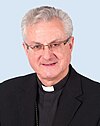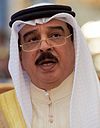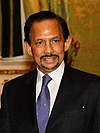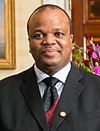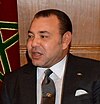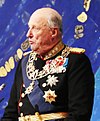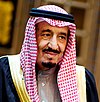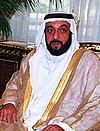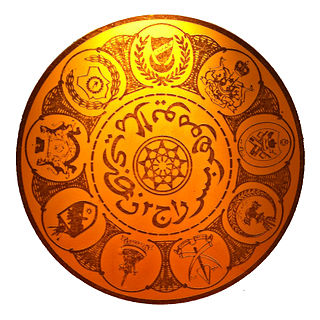


A monarch is the head of a monarchy, a form of government in which a state or polity is ruled by an individual who normally rules for life or until abdication, and typically inherits the throne by birth. [1] Monarchs may be autocrats (as in all absolute monarchies) [2] or may be ceremonial figureheads, exercising only limited or no reserve powers at all, with actual authority vested in a legislature and/or executive cabinet (as in many constitutional monarchies). [3] In many cases, a monarch will also be linked with a state religion. [4] Most states only have a single monarch at any given time, although a regent may rule when the monarch is a minor, not present, or otherwise incapable of ruling. [5] Cases in which two monarchs rule simultaneously over a single state, as is the current situation in Andorra, are known as coregencies. [6]
A monarch is a sovereign head of state in a monarchy. A monarch may exercise the highest authority and power in the state, or others may wield that power on behalf of the monarch. Typically a monarch either personally inherits the lawful right to exercise the state's sovereign rights or is selected by an established process from a family or cohort eligible to provide the nation's monarch. Alternatively, an individual may become monarch by conquest, acclamation or a combination of means. A monarch usually reigns for life or until abdication.
A head of state is the public persona who officially represents the national unity and legitimacy of a sovereign state. Depending on the country's form of government and separation of powers, the head of state may be a ceremonial figurehead or concurrently the head of government. In a parliamentary system the head of state is the de jure leader of the nation, and there is a separate de facto leader, often with the title of prime minister. In contrast, a semi-presidential system has both heads of state and government as the leaders de facto of the nation.

A monarchy is a form of government in which a single person holds supreme authority in ruling a country, also performing ceremonial duties and embodying the country's national identity. Although some monarchs are elected, in most cases, the monarch's position is inherited and lasts until death or abdication. In these cases, the royal family or members of the dynasty usually serve in official capacities as well. The governing power of the monarch may vary from purely symbolic, to partial and restricted, to completely autocratic.
Contents
Monarchs are distinguished by their titles and styles, which in most cases are defined by tradition, and guaranteed under the state's constitution. A variety of titles are applied in English; for example, "king" and "queen", "prince" and "princess", "emperor" and "empress". Although they will be addressed differently in their local languages, the names and titles in the list below have been styled using the common English equivalent. Roman numerals, used to distinguish related rulers with the same name, [7] have been applied where typical.
A style of office, honorific or manner/form of address, is an official or legally recognized form of address, and may often be used in conjunction with a title. A style, by tradition or law, precedes a reference to a person who holds a post or political office, and is sometimes used to refer to the office itself. An honorific can also be awarded to an individual in a personal capacity. Such styles are particularly associated with monarchies, where they may be used by a wife of an office holder or of a prince of the blood, for the duration of their marriage. They are also almost universally used for presidents in republics and in many countries for members of legislative bodies, higher-ranking judges and senior constitutional office holders. Leading religious figures also have styles.

A constitution is an aggregate of fundamental principles or established precedents that constitute the legal basis of a polity, organisation or other type of entity, and commonly determine how that entity is to be governed.
A regnal name, or reign name, is the name used by monarchs and popes during their reigns and, subsequently, historically. Since ancient times, some monarchs have chosen to use a different name from their original name when they accede to the monarchy.
In political and sociocultural studies, monarchies are normally associated with hereditary rule; most monarchs, in both historical and contemporary contexts, have been born and raised within a royal family. [6] [8] Succession has been defined using a variety of distinct formulae, such as proximity of blood, primogeniture, and agnatic seniority. Some monarchies, however, are not hereditary, and the ruler is instead determined through an elective process; a modern example is the throne of Malaysia. [9] These systems defy the model concept of a monarchy, but are commonly considered as such because they retain certain associative characteristics. [10] Many systems use a combination of hereditary and elective elements, where the election or nomination of a successor is restricted to members of a royal bloodline. [11] [12]
Hereditary monarchy is a form of government and succession of power in which the throne passes from one member of a royal family to another member of the same family. It represents an institutionalised form of nepotism.
A royal family is the immediate family of a king or queen regnant, and sometimes his or her extended family. The term imperial family appropriately describes the family of an emperor or empress, and the term papal family describes the family of a pope, while the terms baronial family, comital family, ducal family, archducal family, grand ducal family, or princely family are more appropriate to describe, respectively, the relatives of a reigning baron, count, duke, archduke, grand duke, or prince. However, in common parlance members of any family which reigns by hereditary right are often referred to as royalty or "royals." It is also customary in some circles to refer to the extended relations of a deposed monarch and his or her descendants as a royal family. A dynasty is sometimes referred to as "the House of ...". As of July 2013, there are 26 active sovereign monarchies in the world who rule or reign over 43 countries in all.
An order of succession or right of succession is the sequence of those entitled to hold a high office such as head of state or an honor such as a title of nobility in the order in which they stand in line to it when it becomes vacated. This sequence may be regulated through descent or by statute.
Entries below are listed beside their respective dominions, which are organised alphabetically. These monarchs reign as head of state in their respective sovereign states. Monarchs reigning over a constituent division, cultural or traditional polity are listed under constituent monarchs. For current claimants to abolished thrones, see pretenders.
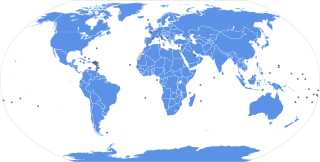
In international law, a sovereign state, sovereign country, or simply state, is a nonphysical juridical entity that is represented by one centralized government that has sovereignty over a geographic area. International law defines sovereign states as having a permanent population, defined territory, one government, and the capacity to enter into relations with other sovereign states. It is also normally understood that a sovereign state is neither dependent on nor subjected to any other power or state.

